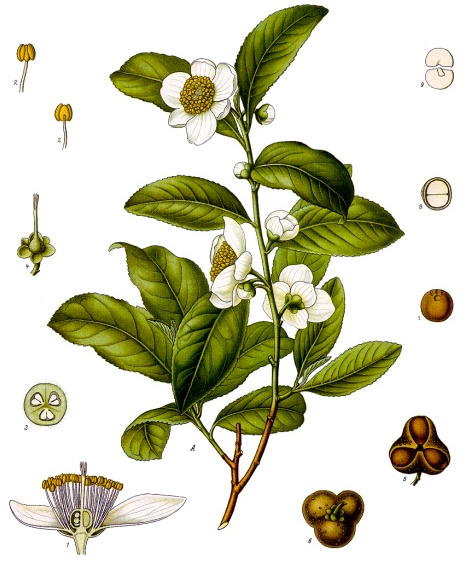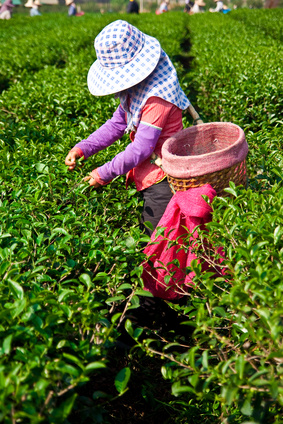Camellia sinensis (L)
Synonyms: C. thea (Link.), Thea sinensis (Sims.), C. theifera (Griff.)
Order: Theaceae
Description: This small evergreen shrub is cultivated in Ceylon, Java, Japan and elsewhere where climate allows. It grows to a height of 2.5m when cultivated, but may reach 30m in the wild. The dark green lanceolate or elliptical leaves grow on short stalks. They are blunt at the apex, with a tapering base and serrate margins. The young leaves are hairy, the older ones glabrous. The flowers can be solitary, or two or three occur together on short branchlets in the leaf axils. They droop from short stalks. The fruit is a smooth, flattened, rounded, trigonous three-celled capsule with a solitary seed in each cell.
Parts used: dried and rolled leaf buds and very young leaves. Oolong tea is partially fermented; black tea is fully fermented.
Constituents: alkaloids (including caffeine and theobromine), tannins (polyphenols), catechins, volatile oil
Actions: stimulant, astringent, diuretic, mildly analgesic, antioxidant, antibacterial; some varieties reduce blood cholesterol levels; anti-tumour properties reported in green tea.
Indications: diarrhoea, dysentery
Therapeutics and Pharmacology: Black tea is used in the treatment of diarrhoea and dysentery and for the relief of neuralgic headaches. It is also a traditional Cantonese remedy for hangovers. The Chinese use tea as an astringent remedy to clear phlegm, and as a digestive remedy. Research has demonstrated that the tannins in some green teas appear to reduce the risk of stomach cancer. Japanese research suggests that oolong tea can reduce high blood pressure and help prevent arterial disease. Green tea is rich in fluoride and so can reduce the risk of tooth decay. It is also useful for insect bites and to stem bleeding. A weak infusion of tea can be used as a cooling wash for sunburn and used teabags can be applied to tired eyes.
 Caution: Excessive quantities may cause
nervous symptoms. Pregnant and nursing women
should limit their consumption to two cups a day as high levels of caffeine can
increase the heart rate. Those with stomach ulcers should take care as the bitter taste
stimulates gastric acid production.
Caution: Excessive quantities may cause
nervous symptoms. Pregnant and nursing women
should limit their consumption to two cups a day as high levels of caffeine can
increase the heart rate. Those with stomach ulcers should take care as the bitter taste
stimulates gastric acid production.
Preparation and Dosage: Moderately drunk by healthy individuals tea is quite harmless.
Additional Comments: The Chinese say, ' better to be deprived of food for three days, than of tea for one'.
Bibliography
Grieve, M. 1931 A Modern Herbal, (ed. C.F. Leyel 1985), London.
Ody, P. 1993 The Herb Society's Complete Medicinal Herbal, Dorling Kindersley, London.










